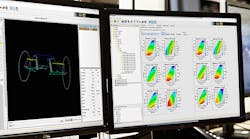Accurately predicting RF link performance early in the design cycle is important for cellular, radar, and satellite applications. Although spreadsheets and rule-of-thumb methods have traditionally been used, they provide limited insight into RF links of next-generation wireless systems. An alternative approach is to utilize RF system simulation software, which is the topic of the white paper “Predicting Critical Metrics for Wireless RF Links” from National Instruments.
Spreadsheets have traditionally been used to calculate parameters, such as cascaded noise figure (NF) and 1-dB compression (P1dB). The white paper notes that spreadsheets offer the benefit of being readily available. They also allow for simple data entry.
However, new complex 5G specifications bring to light the limitations of spreadsheets. The white paper notes that spreadsheets are based on standard equations. Therefore, they do not typically account for other factors, such as mismatches between components. And spreadsheets usually do not support data files (such as touchstone files) and spur tables. Neither yield analysis nor optimization techniques, which are becoming increasingly important, are supported as well.
The white paper explains that a more modern approach is to use a system design software tool. With the Visual System Simulator (VSS) software, designers can start from a spreadsheet interface to define components such as amplifiers and mixers. They can then define the circuit measurements and automatically generate a system diagram.
Three examples are presented to demonstrate the capabilities of system design software. The first involves an RF link that’s analyzed with both a traditional spreadsheet and design software, with each producing different results. Analyzing the local-oscillator (LO) path with the system design software revealed the cause of the discrepancy. Such analysis could not be performed with a spreadsheet, demonstrating the benefits of design software. The second example shows how the software can be used to vary an inductor value of a filter in the link, and then observe the changes in link NF. The third example highlights a spur analysis tool within the software.
AWR Corp., 1960 E. Grand Ave. Suite 430, El Segundo, CA 90245; (310) 726-3000.

